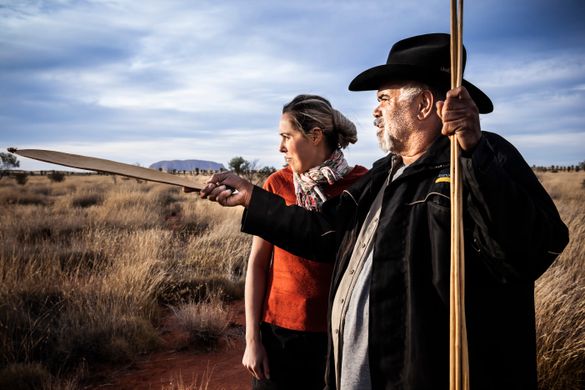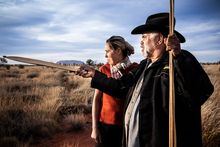 09 Oct 2025
09 Oct 2025
26 October 2025 marks a profound national milestone – 40 years since the Australian Government returned the title deeds of Uluṟu–Kata Tjuṯa National Park to its Traditional Owners, the Aṉangu People.
The 1985 handback was not just a legal shift. It was a cultural and spiritual affirmation of connection to Country, the recognition of Traditional Ownership, and a new beginning for Aboriginal-led tourism - built on respect, storytelling and deep time knowledge. It sparked a national conversation about custodianship and paved the way for other landmark returns of land across Australia.
Today, four decades on, Aboriginal tourism - immersive, diverse and community-led - is one of the fastest-growing sectors in travel, predicted to be worth US$67 billion globally by 2034. From remote deserts to tropical rainforests and ancient volcanic plains, Australian Aboriginal guides are welcoming travellers onto Country and sharing culture in ways that strengthen identity and spark understanding.
“Handbacks like Uluṟu are more than symbolic,” says Nicole Mitchell, Executive Officer of Discover Aboriginal Experiences, a national collective of more than 50 Aboriginal-owned and -guided tourism operators. “They return agency, allow intergenerational knowledge to thrive and create tourism opportunities where communities share culture on their own terms. This isn't just history - it's the foundation for a vibrant, sustainable future.”
“Tourism is one of the most powerful platforms for reconciliation - when done right, it empowers communities, creates jobs, strengthens culture and invites the world to walk with history, not just hear about it.”
The handback of Uluṟu–Kata Tjuṯa in 1985 was a turning point for cultural heritage and land management in Australia. But it also helped reshape how travellers connect with place. Since then, several iconic landscapes have been returned to Aboriginal stewardship. These land handbacks have allowed Traditional Owners to take the lead in conservation, storytelling and visitor experience - creating pathways for cultural tourism that is respectful, enriching and led by those who have walked the land for millennia.
Below are some of the most significant handbacks shaping Aboriginal tourism today.
Uluṟu–Kata Tjuṯa National Park, NT
Handback: 26 October 1985
The return of title deeds to the Aṉangu people was a defining moment in Australian history. Since then, the park has been jointly managed with Parks Australia, blending Aboriginal law and culture with conservation science. Visitors can join SEIT Outback Australia's SEIT Patji tour to explore homelands beyond the rock, led by Aṉangu Traditional Owners who share Tjukurpa (Creation stories), bush survival skills and the legacy of the handback itself.
El Questro / Wilinggin Country, WA
Handback: 2022
A landmark Indigenous Land Use Agreement between the Wilinggin Aboriginal Corporation and the WA Government returned more than 165,000 hectares of Kimberley wilderness to the Wanjina Wungurr Wilinggin people. Part of the land was converted from pastoral lease to freehold and leased back for tourism. Guests can now walk alongside Traditional Owners on the Injiid Marlabu Calls Us experience, where Wilinggin guides share Dreaming stories, bush knowledge and insights into the country's healing power.
Budj Bim Cultural Landscape, VIC
Handback: 1987
In 1987, parts of Budj Bim Country, including the Lake Condah Mission lands, were formally returned to the Gunditjmara peoples. Further management rights were granted in 2008 through a Native Title settlement, and the area is now jointly managed by the Gunditj Mirring Traditional Owners Aboriginal Corporation and Parks Victoria. Recognised as a UNESCO World Heritage site in 2019, Budj Bim is home to one of the oldest known aquaculture systems in the world. Visitors to Budj Bim Cultural Landscape can walk among ancient stone eel traps and World Heritage-listed wetlands, guided by Traditional Owners who share deep knowledge of innovation, engineering and cultural survival.
Nitmiluk National Park, NT
Handback: 1989
The Jawoyn people were granted title to Nitmiluk Gorge in 1989, creating one of the first models of Aboriginal joint management in the Northern Territory. Today, Nitmiluk Tours is entirely owned and operated by the Jawoyn Peoples, offering gorge cruises, canoeing, cultural talks and helicopter tours. These experiences blend ancient traditions with modern hospitality, empowering the community through economic development and cultural preservation.
Daintree Rainforest, QLD
Handback: 2021
In a history-making handover, the Daintree – the oldest tropical rainforest on Earth – was returned to the Eastern Kuku Yalanji people. With it came the right to shape tourism on Country. Through Walkabout Cultural Adventures, guests are guided by Kuku Yalanji Traditional Owners through lush forest and coastal tracks, learning about plant medicine, totems, bush foods and the deep spiritual ties between people and land.
The Legacy Continues
These handbacks are not isolated events – they are part of a broader movement toward truth-telling, reconciliation and restoring balance on Country across Australia.
For Aboriginal tourism operators, land return provides the platform to:
• Reclaim cultural spaces
• Create jobs and training pathways for community
• Share Indigenous knowledge systems with visitors
• Strengthen language and ceremony through lived practice.
Across the Discover Aboriginal Experiences collective, you'll find businesses that are deeply grounded in these principles - from saltwater journeys on the Great Barrier Reef to desert walks, rainforest immersions and city-based cultural tours.
When visitors walk with Aboriginal guides, they're stepping into a different way of seeing the world - one shaped by 65,000 years of connection, innovation and care for Country. These are not performances - they're real, living practices. And every handback helps ensure those practices are protected, shared and celebrated.
Looking Ahead
As Australia marks the 40th anniversary of the Uluṟu-Kata Tjuṯa title deeds handback, there is much to reflect on - and much to anticipate.
“Aboriginal tourism is not simply growing. It is evolving - moving away from tokenistic or superficial offerings and towards immersive, Aboriginal-led experiences with authenticity at their core. It's an invitation to travellers to go deeper, stay longer and walk more softly. For communities, it's about taking control of narrative, ownership of story, and stewardship of Country - as it should always have been, and showcasing it on their terms,” says Mitchell.
And there are endless ways to do just that at Uluru in a respectful way. Think fine dining with native ingredients on a dune overlooking Uluru through the Tali Wiru experience. Or watching Wintjiri Wiru - a drone-and-light show telling the Anangu Mala story. Visiting spiritual sites (with permission) few others can go with an Aboriginal guide on the SEIT Patji experience. Or learning about Aboriginal creativity at the Gallery of Central Australia.
“As visitors engage with the land through guided cultural tours, they gain insight into the stories that have been passed down through generations. From traditional art practices to bush food foraging, these experiences provide a profound connection to the culture of the Anangu people. They not only educate visitors but also empower Indigenous communities by providing them with opportunities to share their culture on their terms.
“We encourage everyone to visit Uluru with a mindset of respect and curiosity. Engage in experiences that promote understanding and appreciation of the Anangu culture. And above all, admire the astonishing beauty and spirituality of this part of the Northern Territory.”
Discover more about what a sacred Aboriginal site is, and how you can be respectful here.
Editor's Note:
The Discover Aboriginal Experiences collective is part of Tourism Australia's Signature Experiences of Australia program that promotes outstanding tourism experiences within a variety of special categories. This collection showcases a diversity of experiences delivered by the world's oldest living cultures, creating memorable trips for adventure seekers, culture enthusiasts, foodies and nature lovers, ranging from exploring hidden rock art galleries to foraging for native delicacies, stand-up paddleboarding on culturally significant waterways to bedding down at wilderness lodges in serene natural settings. Each member of this collection is considered a world-class leader in Aboriginal tourism, representing local Aboriginal cultures with integrity and authenticity.
Find out more about the Discover Aboriginal Experiences collective via our website. From the website you can access a dedicated trade and media portal, replete with a media kit packed with story ideas, interviews, Discover Aboriginal Experiences resources and more. Keep up to date and be inspired via our Connect to Country digital magazines.
A collection of royalty-free Aboriginal tourism images and video are available here. Please search for Discover Aboriginal Experiences in the Resources section.
For further information contact:
Nicole Mitchell – Tourism Australia
Executive Officer Discover Aboriginal Experiences
T: +61 410 499 525
E: nmitchell@tourism.australia.com
W: discoveraboriginalexperiences.com
In North America – Julie Earle-Levine
PR for Discover Aboriginal Experiences
E: Julie@julieearle.net



